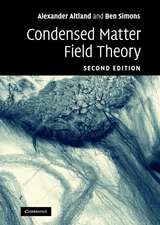Electron Correlation in Molecules and Condensed Phases: Physics of Solids and Liquids
Autor Norman H. Marchen Limba Engleză Hardback – 31 oct 1996
| Toate formatele și edițiile | Preț | Express |
|---|---|---|
| Paperback (1) | 1222.31 lei 6-8 săpt. | |
| Springer Us – 23 iun 2013 | 1222.31 lei 6-8 săpt. | |
| Hardback (1) | 1228.62 lei 6-8 săpt. | |
| Springer Us – 31 oct 1996 | 1228.62 lei 6-8 săpt. |
Din seria Physics of Solids and Liquids
- 20%
 Preț: 569.92 lei
Preț: 569.92 lei - 20%
 Preț: 1259.15 lei
Preț: 1259.15 lei - 18%
 Preț: 951.47 lei
Preț: 951.47 lei - 18%
 Preț: 1239.37 lei
Preț: 1239.37 lei - 24%
 Preț: 1555.85 lei
Preț: 1555.85 lei - 18%
 Preț: 952.40 lei
Preț: 952.40 lei - 18%
 Preț: 1232.26 lei
Preț: 1232.26 lei - 18%
 Preț: 1240.62 lei
Preț: 1240.62 lei - 18%
 Preț: 1114.34 lei
Preț: 1114.34 lei - 18%
 Preț: 1236.82 lei
Preț: 1236.82 lei - 18%
 Preț: 1392.95 lei
Preț: 1392.95 lei - 15%
 Preț: 650.55 lei
Preț: 650.55 lei - 15%
 Preț: 646.43 lei
Preț: 646.43 lei -
 Preț: 409.69 lei
Preț: 409.69 lei -
 Preț: 396.78 lei
Preț: 396.78 lei -
 Preț: 387.58 lei
Preț: 387.58 lei -
 Preț: 406.80 lei
Preț: 406.80 lei -
 Preț: 408.37 lei
Preț: 408.37 lei -
 Preț: 409.30 lei
Preț: 409.30 lei -
 Preț: 384.31 lei
Preț: 384.31 lei -
 Preț: 434.72 lei
Preț: 434.72 lei - 15%
 Preț: 660.04 lei
Preț: 660.04 lei
Preț: 1228.62 lei
Preț vechi: 1498.31 lei
-18% Nou
Puncte Express: 1843
Preț estimativ în valută:
235.12€ • 255.31$ • 197.50£
235.12€ • 255.31$ • 197.50£
Carte tipărită la comandă
Livrare economică 22 aprilie-06 mai
Preluare comenzi: 021 569.72.76
Specificații
ISBN-13: 9780306448447
ISBN-10: 0306448440
Pagini: 396
Ilustrații: XVI, 396 p.
Dimensiuni: 155 x 235 x 24 mm
Greutate: 0.76 kg
Ediția:1996
Editura: Springer Us
Colecția Springer
Seria Physics of Solids and Liquids
Locul publicării:New York, NY, United States
ISBN-10: 0306448440
Pagini: 396
Ilustrații: XVI, 396 p.
Dimensiuni: 155 x 235 x 24 mm
Greutate: 0.76 kg
Ediția:1996
Editura: Springer Us
Colecția Springer
Seria Physics of Solids and Liquids
Locul publicării:New York, NY, United States
Public țintă
ResearchCuprins
1. Outline.- 2. Electron Density, Density Matrices and Atomic Properties.- 3. Homogeneous and Inhomogeneous Electron Assemblies.- 4. Localized versus Molecular Orbital Theories of Electrons.- 5. Quantum Monte Carlo Calculation of Correlation Energy.- 6. Quasiparticles and Collective Excitations (Especially Plasmons).- 7. Metal-Insulator Transitions and the Chemical Bond.- 8. Electronic Correlation in Disordered Systems (Especially Liquid Metals).- 9. Magnetically Induced Wigner Solid.- Appendixes.- Appendix to Chapter 2.- A2.1. Density Matrices for Many-Particle Oscillator Model.- A2.2. Atomic Energies from Renormalization of Large-Dimensionality Results.- A2.3. Size-Extensivity, Cumulants, and Coupled-Cluster Equations.- A2.3.1. Different Representations of ?.- A2.3.2. Calculating the Ground-State Energy.- A2.3.3. Derivation of the Coupled-Cluster Equations.- A2.3.4. Independent Mode Approximation.- A2.4. The Hiller—Sucher—Feinberg Identity and Improvement of Cusp Condition.- A2.5. Two Electrons with Coulomb Interaction Moving in an External Oscillator Potential.- A2.5.1. Solution of Schrödinger Equation.- A2.5.2. An Exact Solution.- A2.5.3. Results.- A2.5.4. Some Physical Consequences.- Appendix to Chapter 3.- A3.1. Example of Spin Density Description: Bloch’s Hartree—Fock Treatment.- A3.2. Wave-Number Dependent Magnetic Susceptibility.- A3.3. Koster—Slater-Like Model of Criterion for Local Moment Formation.- A3.4. Dynamic Properties of Jellium.- A3.4.1. Response Function and Screening.- A3.4.2. Random Phase Approximation and Beyond.- A3.5. Static Local-Field and Dielectric Function Applied to Screened Interactions in Metals.- Appendix to Chapter 4.- A4.1. Model of Two-Electron Homopolar Molecule.- A4.2. Dependence on Atomic Number of Correlation Energiesin Neutral Atoms.- A4.3. Correlation Energy of Diatomic Molecules versus Number of Electrons.- A4.4. Effect of Correlation on von Weizsäcker Inhomogeneity Kinetic Energy: Scaling Properties and Molecular Dissociation.- Appendix to Chapter 5.- Appendix to Chapter 6.- A6.2. Thomas—Fermi Model of Static Dielectric Function of Semiconductor.- A6.3. Semiempirical Self-Energy Corrections to Density Functional (LDA) Bands of Semiconductors.- A6.3.1. Summary of Technique.- A6.3.2. Some Specific Examples.- A6.5. Coefficients in the Continued Fraction Expansion.- A6.6. Plasmon Properties and Effective Screened Interaction.- A6.6.1. Screened Interaction.- A6.6.2. Plasmon Properties.- A6.7 Some Difficulties with Plasmon-Pole Approximations and Proposed Remedies.- A6.8 Different Forms of GW Approximations.- A6.8.1. Vertices and Self-Energies.- A6.8.2. Summary of Effects of Exchange and Correlation.- Appendix to Chapter 7.- A7.1. Relation of Resonating Valence Bond and Gutzwiller Methods.- A7.2. Reduction of Hubbard and Emery Models to Effective Spin Hamiltonians.- A7.2.1. Hubbard Hamiltonian with Strong Electron Repulsion Energy.- A7.2.2. Emery Model.- A7.3. Luttinger Liquid: Spinons and Holons.- A7.3.1. Spin—Charge Separation.- A7.3.2. Can a 2D Luttinger Liquid Exist?.- A7.3.3. Spinons, Holons and Gapless Spin Excitations.- A7.5. Electron Liquids Flowing through Antiferromagnetic Assemblies.- Appendix to Chapter 9.- A9.1. Electron Liquids and the Quantized Hall State.- A9.2. Melting Criteria for Three-Dimensional Classical and Quantal Wigner Crystals.- A9.3. Wigner Oscillator in Magnetic Field of Arbitrary Strength.- A9.4. Shear Modulus, Electron Density Profile, and Phase Diagram for Two-Dimensional Wigner Crystals.- A9.4.1. Observation of Magnetically Induced Wigner Solid(MIWS).- A9.4.2. Electron Density Profile and Shear Modulus.- A9.4.3. Limiting Cases: Instabilities and Melting.- A9.4.4. The Magnetically Induced Wigner Solid (MIWS).- A9.4.5. Discussion and Summary.- References.
Recenzii
`This book serves the purpose of introducing the reader to the variety of advanced techniques available to study electron correlations in condensed systems.'
d Science
d Science

















